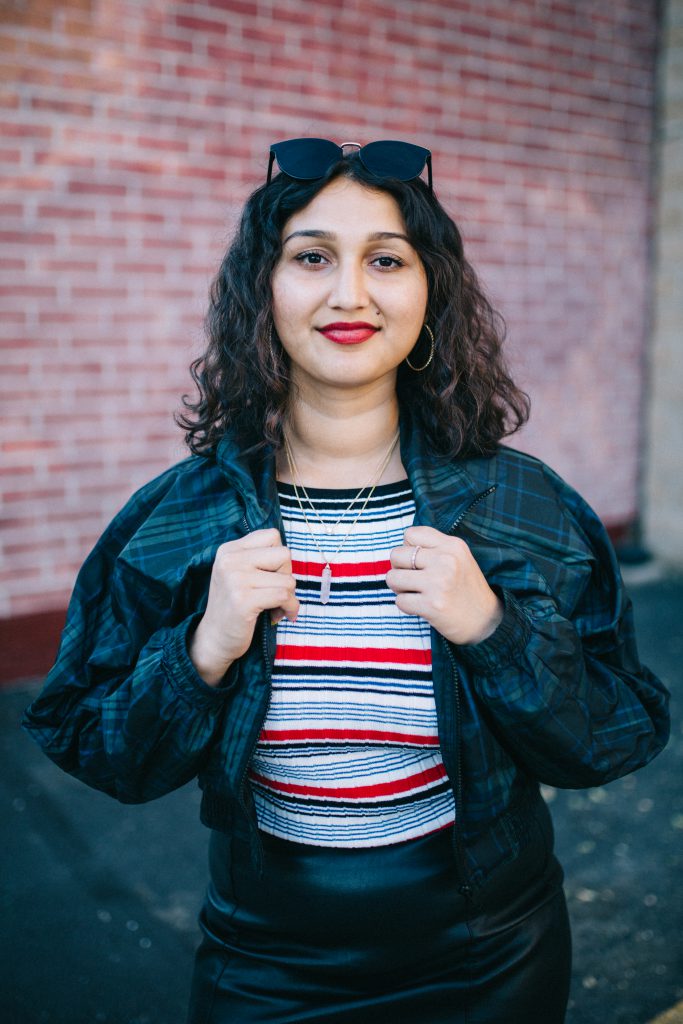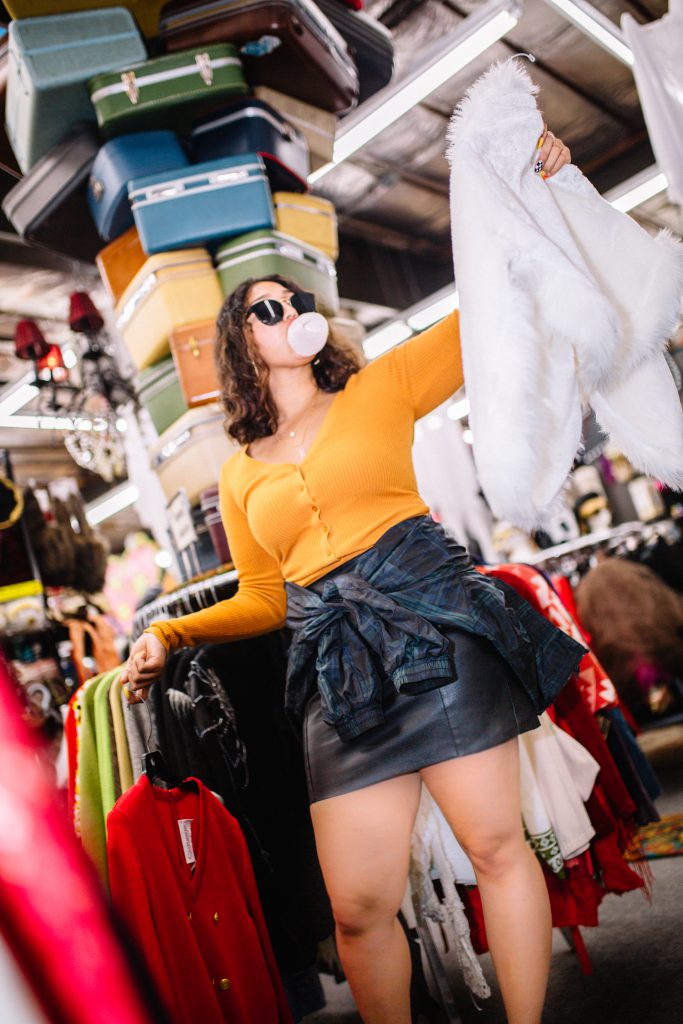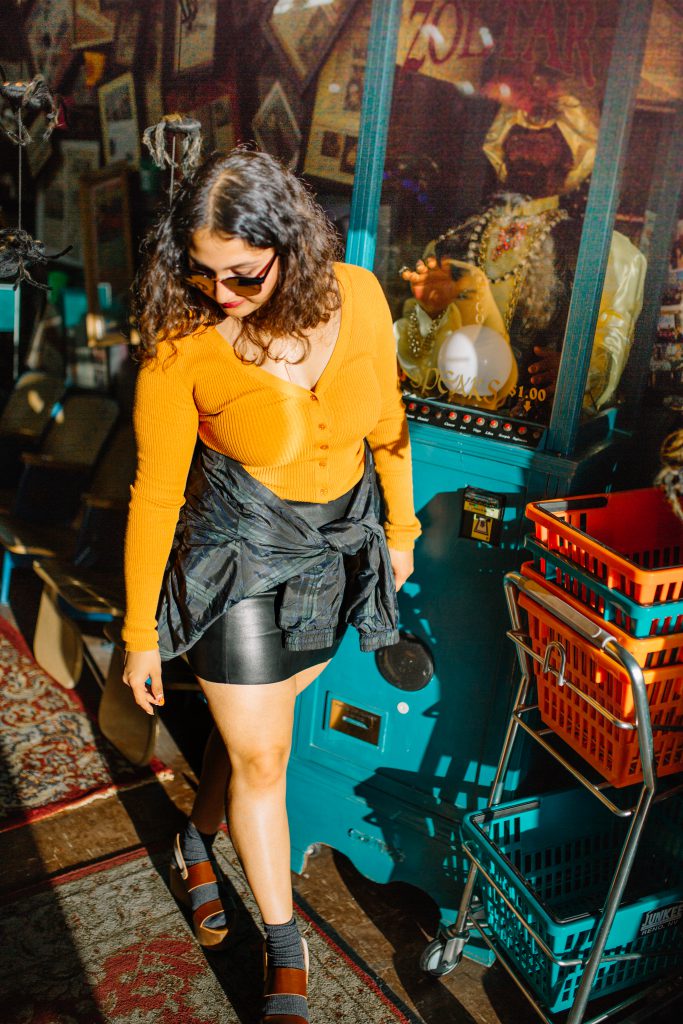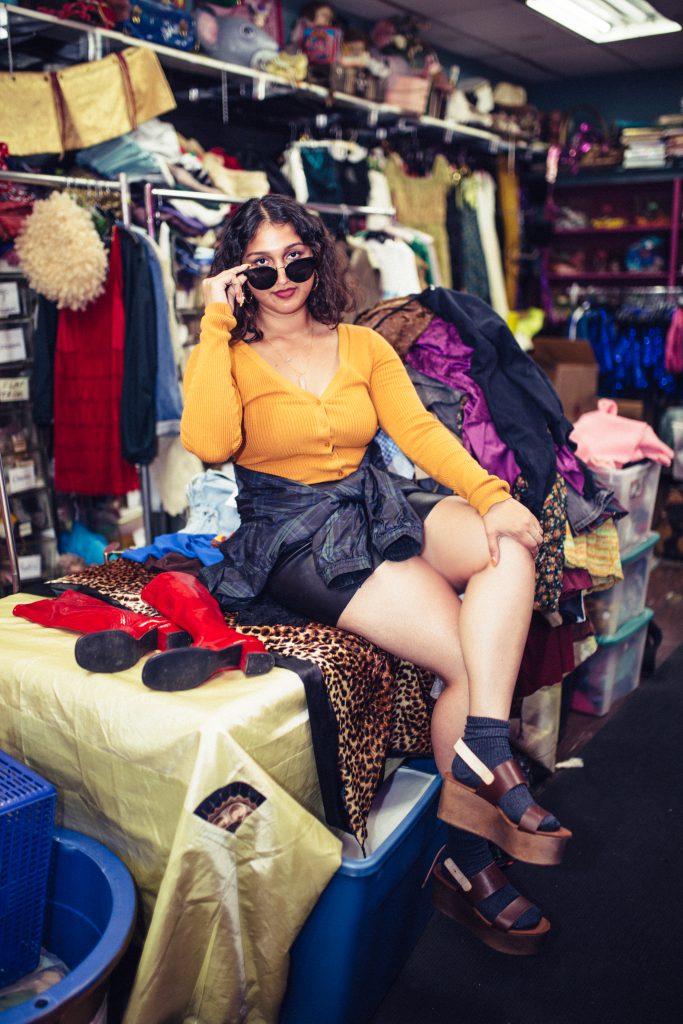
 As a child, my grandmother and I would take the public bus and wander into flea markets and thrift stores. Because of this, I like to say I grew up in them. She enjoyed spending the day looking for unique clothing and home decor. As I drank strawberry juice at flea markets and played with dolls in thrift stores, my grandmother would look through dresses, vases, and more, looking for the next thing to bring home. I didn’t know then, but my grandmother was an expert thrifter. Thanks to her, I became one, too, but now with a conscious, ethical twist.
As a child, my grandmother and I would take the public bus and wander into flea markets and thrift stores. Because of this, I like to say I grew up in them. She enjoyed spending the day looking for unique clothing and home decor. As I drank strawberry juice at flea markets and played with dolls in thrift stores, my grandmother would look through dresses, vases, and more, looking for the next thing to bring home. I didn’t know then, but my grandmother was an expert thrifter. Thanks to her, I became one, too, but now with a conscious, ethical twist.
Like most teenagers, I spent my weekends at the mall. I would run to stores like Forever 21 to buy the trendiest clothing of the week. Though I would spend my money on different items, my closet never seemed to grow. It wasn’t until this summer I realized that I had fallen victim to fast fashion where I was valuing the quantity of clothing rather than the quality of it. Fast fashion is the mass production of cheap and trendy clothing. Because companies want to produce in a fast and cheap way to earn a quick buck, the quality of clothing becomes unsatisfactory, and the wages for those who make the clothing become nearly non-existent.
According to The Los Angeles Times, The U.S. Department of Labor investigated garment factories and found that workers were earning four to seven dollars an hour for 10 hour shifts sewing clothes for companies like Forever 21. Workers are earning cents for each item they sew, thus earning less than minimum wage because sewing cannot be done quickly. Companies are violating basic minimum wage laws and trying to find loopholes by hiring immigrant workers who are fine with a small wage. The exploitation of workers is being done in the name of fashion, but at what cost? Sure, the consumer is purchasing a trendy new top, but behind it is exploitation, violation, and cheap fabric that only pushes the consumer to go on and buy more clothes to make up for their losses.
 Shopping slow fashion, which is the focus on ethical fashion that pays their workers ethical wages and uses ethical fabrics, can be a great solution to cutting your own ties with fast fashion. Whether you want to stop shopping from big brands like Ross, TJ Maxx, Forever 21, H&M, and Zara who support fast fashion because of ethical reasons and or an excuse to start collecting ethical and unique pieces for your wardrobe, is up to you. When I started my fast fashion and slow fashion research, I realized I always had my feet in the slow fashion pool by thrifting. Slow fashion can be expensive and intimidating, but with options like shopping occasionally, thrifting, antique shopping, upcycling clothing, shopping locally, and shopping online on apps that support thrifting and ethical fashion, you can adopt slow fashion into your life without hurting your wallet.
Shopping slow fashion, which is the focus on ethical fashion that pays their workers ethical wages and uses ethical fabrics, can be a great solution to cutting your own ties with fast fashion. Whether you want to stop shopping from big brands like Ross, TJ Maxx, Forever 21, H&M, and Zara who support fast fashion because of ethical reasons and or an excuse to start collecting ethical and unique pieces for your wardrobe, is up to you. When I started my fast fashion and slow fashion research, I realized I always had my feet in the slow fashion pool by thrifting. Slow fashion can be expensive and intimidating, but with options like shopping occasionally, thrifting, antique shopping, upcycling clothing, shopping locally, and shopping online on apps that support thrifting and ethical fashion, you can adopt slow fashion into your life without hurting your wallet.
Creating an ethical wardrobe and adopting the slow fashion lifestyle has its pros and cons. I like to think that the slow fashion journey outweighs the cons, though. I have found that thrifting and antique shopping have helped me see my wardrobe as a collection of things that make me feel good and look just as good. Thrifting and antiquing has strengthened my relationship with fashion by valuing and cherishing what I have. I now spend my time looking for what best fits my body and my personality. I don’t spend my time looking for the trendiest thing or what the next person has.
Aside from this, slow fashion has also saved me money. Kelsey Tabbert, Depop seller and vintage clothing enthusiast, has been selling on Depop since January of 2017, and has found success selling vintage clothing on Depop, an app where you can sell and shop second-hand clothing. Much like thrifting and antique shopping online. Tabbert believes shopping vintage shouldn’t hurt your wallet and should instead excite you and encourage you through your slow fashion journey.
“Really put in the work finding yourself out in the wild. It takes a lot of work, but it can be rewarding. The search can be half the fun! Make sure you hit up your thrift stores on sale days to even save more. If you’re really devoted, you can also keep an eye out for local estate sales,” she said.
Though Tabbert encourages looking out for vintage clothing, she also encourages thrifting to find affordable clothing, “You can find current brands for cheap. It’s great for the environment and great for your wallet.” Which is true as well.
Clothes that don’t get purchased from thrift stores or clothes that you casually throw in the trash end up clogging up our landfills. Once they make it to the landfills, they increase our carbon footprint because of the carbon dioxide emissions from their production and disposal, according to The Guardian. Though it’s a good idea to donate your clothes to thrift stores like Goodwill, stores like Goodwill receive hundreds of items everyday. They end up having to discard their old inventory in landfills to make room for the new. Instead, I recommend you to use old clothes as cleaning rags, donating them to local centers where they go directly to people in need, or even exchanging them or selling them online or at shops like Plato’s Closet.
Lastly, cutting out fast fashion encourages you to shop local and shop from local artists. Earlier this fall, I moved to London, England, and was worried about not being able to shop from local artists and shops that support the local community. London, known for being one of the most expensive cities in the world, houses shops like Primark that are on the cheaper side thus more appealing.
Being new to the city, I was tempted to go in and buy affordable clothes in this nearly unaffordable city, but instead tried finding local clothing shops. Walking in my neighborhood one day, I found Vivien of Holloway, a shop that sells clothing and accessories inspired by the mid 20th century. Looking through the racks, I found a shirt I wanted and asked the employee how this shirt was made and what their shop advocates for. She told me that each section belongs to a designer who creates and designs their own clothing. Designers make a limited amount and take their time to sew and create each piece, making it unique to Vivien of Holloway. I purchased the shirt and left the shop knowing I supported a designer and their craft. Side note: Don’t be afraid to ask questions. Stores that are running things ethically would be more than happy to talk about their inventory and message.
Though slow fashion has made me happier, I am still in the process of dedicating my wardrobe to solely slow fashion. I’m a college student with a tight budget and a love for fashion, so it is difficult to pass by shops with sales and not want to buy it all. I would say that a slow fashion con is that, well, it is slow. Slow fashion means that you won’t always be the friend with all the shopping bags and the shiny, new things. But you will be the friend with the things that you need and things that you know you will cherish for a long time while slowly finding your style and finding clothes you love. Fast fashion is tempting though, but I have decreased my fast fashion intake by a great percentage. Another con is shopping for essentials like undergarments. You could go deep into your journey and shop only from ethical shops for everything including undergarments, but it will get pricey. I suggest to shop undergarments from shops that you usually shop from, but focus on taking good care of them and only buying new stuff when necessary.
How to stop shopping fast fashion:
Quality Over Quantity: Spending a hundred dollars on a pair or two of jeans might sound insane at first, but looking at it from a long-term perspective might change your mind. If you focus on buying a few items a year that are costly but well made, you will eventually save money. Sure, you can buy four pairs of jeans in one trip, but they will eventually fail you after a few weeks or months by getting damaged or discolored in the wash. You would have to go back and repurchase, spending more money in the end.
Thrifting Dates with Friends: Get your friends into lowering their fast fashion intake, too, by inviting them on thrifting dates. Creating a small circle of friends that thrift is a great way to bond and add new clothes to your wardrobe. Second-hand shopping avoids your consumption of new and mass produced clothes. I have found lovely clothes that have lasted me years at thrift stores.
Shop Eco-Friendly Clothing: There are many shops online that use organic and natural biodegradable materials. Fast fashion clothing tends to use toxic and cheaply made fabrics that aren’t good for you or the environment. Eco-Friendly clothing companies are likely to push the ethical agenda and are most likely to pay their workers an ethical wage. Look out for the about me section on company websites. Remember, if they are doing everything right they will most likely be proud and talk about it on their website. You can always call or email them with your questions.
Shop on Apps: During the summer I fell in love with Depop. Though I sold a few items here and there, I mainly used Depop to shop affordable, vintage clothes and engage with fellow fashion lovers. Depop is a friendly community with even friendlier sellers that have helped me collect vintage clothes without overspending. Depop also sells second-hand clothing aside from their vintage clothes. Some of my favorite shops are Kelsey’s shop, Full of Sand: Midwest Thrifts, Twitch Vintage, Unicorn Tears XD, Mute Style, Lady Paige Thrift, Hunnybee Vintage, and The Prairie Misfit.
Shop Locally: I mentioned this earlier, but shopping locally and from local artists is a great way to lower your fast fashion intake. After visiting Midtown’s shops like Junkee and Bad Apple Vntg, I noticed these shops had things made by local artists and used clothes on their racks. Junkee sells vintage clothing and antiques, but also has a section in the antiques section that sells goods made by local Reno artists. Bad Apple Vntg sells random goodies, but their small vintage selection is wonderful. I bought my favorite denim top with a cherry print from the 90s there! Aside from supporting local artists, shopping locally also helps the community’s local economy.
Take Care of Your Current Clothes: I still own some fast fashion items like my favorite denim jacket and my favorite leather jacket. Though I bought these long ago, I have tried to take care of my clothes by washing them with the right detergent and following what the handling tag advises. Sure, I bought both from Zara, known for its fast fashion reputation, but taking care of them helps me avoid going back and giving my money to these type of companies. For my non-fast fashion items, I take care of them, too. I try to keep them that way by washing them right and sometimes even air drying.
If for any reason you cannot stop shopping at your local mall, it’s alright! Just being aware and attempting to cut down your fast fashion purchases can help. It’s a journey and should be enjoyable. I have had my moments of guilt for shopping at a fast fashion store, but then quickly correct myself by remembering that I’m starting this journey and should take my time. I also stop and remember that I’m not only doing this for myself and my wallet, but also for unethical wages, toxic fabrics and mass production, my community, and for the environment. Having these thoughts keep me patient. I have made great progress over these last few months and hope to continue. If you decide to rethink your purchases, have fun piecing your ethical wardrobe and rocking your new finds!
